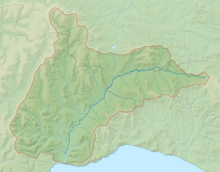River Axe (Lyme Bay)
| River Axe | |
|---|---|
 The River Axe near Axminster | |
 Course and catchment of the River Axe | |
| Location | |
| Country | England |
| Counties | Devon, Dorset, Somerset |
| Physical characteristics | |
| Source | |
| • location | Chedington, Dorset |
| • coordinates | 50°50′22″N 2°43′02″W / 50.83953°N 2.71711°W |
| Mouth | Lyme Bay, English Channel |
• location | Seaton, Devon |
• coordinates | 50°42′07″N 3°03′18″W / 50.70200°N 3.05509°W |
| Basin features | |
| Tributaries | |
| • left | Blackwater River |
| • right | River Yarty, River Coly |

The River Axe is a 22-mile (35 km) long river in the counties of Dorset, Somerset and Devon, in the south-west of England. It rises in Dorset and flows south to Lyme Bay which it enters through the Axe Estuary in Devon. It is a shallow, non-navigable river, although its mouth at Seaton has some boating activity. The name Axe derives from a Common Brittonic word meaning "abounding in fish", and is cognate with pysg (a variant of pysgod), the Welsh word for fish.[1][2][3][4]
The River Axe rises in several streams to the south of Chedington in Dorset, close to the source of the River Parrett that flows north to the Bristol Channel. The Axe then flows west through Mosterton and Seaborough before turning south and forming the county boundary between Dorset and Somerset. In this section it flows past the villages of Wayford and Winsham, and the former Forde Abbey. At a point some 3 miles (4.8 km) north of Axminster it is joined by the Blackwater River and enters the county of Devon. It is then joined by the River Kit, before passing through Axminster after which it is joined by the River Yarty and continues south by the villages of Whitford and Colyford, where it is joined by the River Coly. At this point it spreads out to form the tidal Axe Estuary. The estuary flows past the village of Axmouth, on its eastern bank, before passing through a high shingle bank to the east of the seaside town of Seaton and entering Lyme Bay on the English Channel.[1][2][3]
In 1999, a section of the river extending for 13 kilometres (8.1 mi)—from the confluence with the Blackwater River to Colyford Bridge—was designated a

Although now shallow and largely unnavigable, the estuary of the Axe was once important for shipping. According to Historic England, the village of Axmouth, which is some 1 mile (1.6 km) inland, 'was ranked as a major port by the mid-14th century and accounted for 15% of the country’s shipping trade'. The remains of a late medieval fishing boat can be seen at low tide in the river, just south-west of Axmouth village. Over the following years the estuary silted up and a moving shingle bar formed at the mouth. In 1870 the current Axmouth Harbour was developed at the river mouth. Although the harbour is nearer the town of Seaton than the village of Axmouth, the harbour and all of the estuary are in the parish of Axmouth.[3][6][7]
The estuary is flanked to its west by a series of low-level
Prehistoric archaeology: The Axe valley has produced evidence for some of the earliest human (Palaeolithic) activity in the south-west of England. The Broom gravel pits (near Holditch) produced at least 1,800 Lower Palaeolithic handaxes when they were quarried in the late 19th century and the 1930s and 1940s.[10] More recent archaeological investigations[11] suggested that these artefacts are around 300,000 years old. Similar artefacts have been found in the gravel pits around Chard Junction.[12]
References
- ^ ISBN 978-0-319-24317-6.
- ^ ISBN 978-0-319-24318-3.
- ^ a b c "Parish Biodiversity Audit for Axmouth" (PDF). Devon County Council. Archived from the original (PDF) on 15 December 2013. Retrieved 14 December 2013.
- ^ Witcombe 2009, p. 202.
- ^ a b c d e "River Axe SSSI citation" (PDF). Natural England. Archived (PDF) from the original on 21 July 2021. Retrieved 5 February 2012.
- ^ "Three Historic Shipwrecks Given Protection". Historic England. 15 August 2016. Archived from the original on 16 August 2016. Retrieved 26 May 2019.
- ^ "Three of England's oldest shipwrecks can still be seen on sand and mud in Devon". Culture24. 15 August 2016. Archived from the original on 16 August 2016. Retrieved 26 May 2019.
- ^ "Nature Reserves in the area". Axe Vale & District Conservation Society. Archived from the original on 21 July 2021. Retrieved 21 July 2021.
- ^ "Visiting Seaton Wetlands". East Devon District Council. Archived from the original on 21 July 2021. Retrieved 21 July 2021.
- ^ Moir, J.R. (1936). "Ancient man in Devon". Proceedings of the Devon Archaeological Exploration Society. 2 (4): 264–275.
- ISBN 9781842175200.
- ISBN 0907780822.
Further reading
- George Pulman The Book of the Axe: containing a piscatorial description of that stream, with brief histories of the more remarkable places on its banks, and a variety of tales, songs, and anecdotes
- --do.--2nd ed. London: Hamilton, Adams, and Co., 1844
- --do.--3rd ed., enlarged. London: Longman, Brown, Green, and Longmans, 1853
- --do.--4th ed., re-written. London: Longman, Green, Reader, and Dyer, 1875
- --do.--reprinted. Bath: Kingsmead Reprints, 1969
- Witcombe, Richard (2009). Who was Aveline anyway?: Mendip's Cave Names Explained (2nd ed.). Priddy: Wessex Cave Club. ISBN 978-0-9500433-6-4.
External links
- Glavan, Matjaz. Investigation of the impact of land use management scenarios on diffuse source nutrients in the River Axe catchment (MSc). Cranfield University. Retrieved 16 January 2021.
